Sex-specific role of myostatin signaling in neonatal muscle growth, denervation atrophy, and neuromuscular contractures
- PMID: 36314781
- PMCID: PMC9873256
- DOI: 10.7554/eLife.81121
Sex-specific role of myostatin signaling in neonatal muscle growth, denervation atrophy, and neuromuscular contractures
Abstract
Neonatal brachial plexus injury (NBPI) causes disabling and incurable muscle contractures that result from impaired longitudinal growth of denervated muscles. This deficit in muscle growth is driven by increased proteasome-mediated protein degradation, suggesting a dysregulation of muscle proteostasis. The myostatin (MSTN) pathway, a prominent muscle-specific regulator of proteostasis, is a putative signaling mechanism by which neonatal denervation could impair longitudinal muscle growth, and thus a potential target to prevent NBPI-induced contractures. Through a mouse model of NBPI, our present study revealed that pharmacologic inhibition of MSTN signaling induces hypertrophy, restores longitudinal growth, and prevents contractures in denervated muscles of female but not male mice, despite inducing hypertrophy of normally innervated muscles in both sexes. Additionally, the MSTN-dependent impairment of longitudinal muscle growth after NBPI in female mice is associated with perturbation of 20S proteasome activity, but not through alterations in canonical MSTN signaling pathways. These findings reveal a sex dimorphism in the regulation of neonatal longitudinal muscle growth and contractures, thereby providing insights into contracture pathophysiology, identifying a potential muscle-specific therapeutic target for contracture prevention, and underscoring the importance of sex as a biological variable in the pathophysiology of neuromuscular disorders.
Keywords: developmental biology; mouse; muscle atrophy; muscle length; myostatin; neonatal denervation; neuromuscular contractures; sex dimorphisms.
© 2022, Emmert et al.
Conflict of interest statement
ME, PA, KS, QG, RC No competing interests declared, SL consulting fees from Biohaven Pharmaceuticals, Inc, and Alnylam Pharmaceuticals, Inc; payment/honoraria: Regeneron Pharmaceuticals, Inc; patent: "Therapeutics targeting transforming growth factor beta family signaling"
Figures
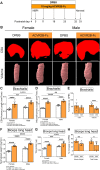
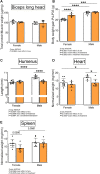
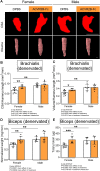


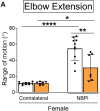
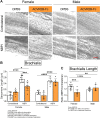
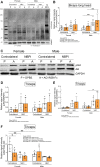
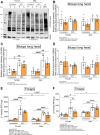

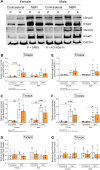
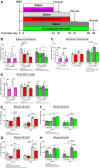
Similar articles
-
Timing of proteasome inhibition as a pharmacologic strategy for prevention of muscle contractures in neonatal brachial plexus injury.FASEB J. 2021 Feb;35(2):e21214. doi: 10.1096/fj.202002194. Epub 2020 Nov 25. FASEB J. 2021. PMID: 33236396 Free PMC article.
-
Proteasome inhibition preserves longitudinal growth of denervated muscle and prevents neonatal neuromuscular contractures.JCI Insight. 2019 Dec 5;4(23):e128454. doi: 10.1172/jci.insight.128454. JCI Insight. 2019. PMID: 31661460 Free PMC article.
-
NRG/ErbB signaling regulates neonatal muscle growth but not neuromuscular contractures in neonatal brachial plexus injury.FEBS Lett. 2021 Mar;595(5):655-666. doi: 10.1002/1873-3468.14034. Epub 2021 Jan 28. FEBS Lett. 2021. PMID: 33421114 Free PMC article.
-
PI3 kinase regulation of skeletal muscle hypertrophy and atrophy.Curr Top Microbiol Immunol. 2010;346:267-78. doi: 10.1007/82_2010_78. Curr Top Microbiol Immunol. 2010. PMID: 20593312 Review.
-
Myostatin and muscle atrophy during chronic kidney disease.Nephrol Dial Transplant. 2021 Nov 9;36(11):1986-1993. doi: 10.1093/ndt/gfaa129. Nephrol Dial Transplant. 2021. PMID: 32974666 Review.
Cited by
-
Sexual dimorphisms in skeletal muscle: current concepts and research horizons.J Appl Physiol (1985). 2024 Aug 1;137(2):274-299. doi: 10.1152/japplphysiol.00529.2023. Epub 2024 May 23. J Appl Physiol (1985). 2024. PMID: 38779763 Free PMC article. Review.
-
The role of sympathetic innervation in neonatal muscle growth and neuromuscular contractures.FEBS J. 2023 Oct;290(20):4877-4898. doi: 10.1111/febs.16908. Epub 2023 Jul 24. FEBS J. 2023. PMID: 37462535 Free PMC article.
References
-
- Bodine SC, Stitt TN, Gonzalez M, Kline WO, Stover GL, Bauerlein R, Zlotchenko E, Scrimgeour A, Lawrence JC, Glass DJ, Yancopoulos GD. Akt/Mtor pathway is a crucial regulator of skeletal muscle hypertrophy and can prevent muscle atrophy in vivo. Nature Cell Biology. 2001;3:1014–1019. doi: 10.1038/ncb1101-1014. - DOI - PubMed
-
- Campbell C, McMillan HJ, Mah JK, Tarnopolsky M, Selby K, McClure T, Wilson DM, Sherman ML, Escolar D, Attie KM. Myostatin inhibitor ACE-031 treatment of ambulatory boys with Duchenne muscular dystrophy: results of a randomized, placebo-controlled clinical trial. Muscle & Nerve. 2017;55:458–464. doi: 10.1002/mus.25268. - DOI - PubMed
Publication types
MeSH terms
Substances
Grants and funding
LinkOut - more resources
Full Text Sources
Miscellaneous

